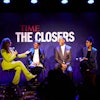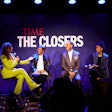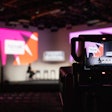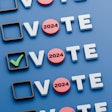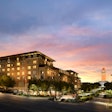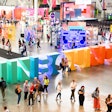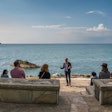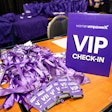We all know clutter can distract us in our homes and workspaces. But have you ever thought how clutter can be disruptive to attendees at your meetings or events?
I sat down with Dr. Brynn Winegard, an award-winning professor, speaker and expert on psychology and brain science, to discuss the most optimal meeting room setup to keep attention at the front of the room and your attendees ready to learn.
“Space is very important to the brain,” says Winegard. People can get overwhelmed, which leads to “cognitive clutter.”
This can happen with a meeting room set in half-rounds or pod seating. Winegard understands it’s difficult to negate clutter with all the required tables and chairs at events.
However, she suggests choosing a venue with sleeker and more modern furniture.
I recently did a site visit at Hotel X Toronto and noticed one of its smaller meeting rooms was set up classroom-style with chairs in rows of yellow and purple.
By color blocking the chairs, the room looked less cluttered. The clean lines made the room feel more spacious (which the brain loves!).
Winegard explains theater-style setups are optimal for getting and keeping attention.
Classroom-style comes in a close second, she says. She warns that half-rounds or pod seating is not an ideal learning environment, especially when technology is involved. When someone at the table is using their laptop or phone, the people around them are more distracted than the person on their device.
“It is almost impossible for anyone witnessing someone else using technology to pay attention.”
I can attest to this, as I recently attended a conference and my peers were all on their laptops—which completely distracted me. She continues to explain that the people on their laptops or phones are still able to listen to the speaker and are less distracted than those who are not.
But while you may be able to listen while on your laptop, research suggests you are not likely to learn anything. If your attendees are on their laptops answering emails or even taking notes, they are not encoding the presented information.
Research on college students taking notes on their laptops versus writing them down demonstrates that those on their laptops had a lower retention of the material than those who took notes by hand.
Taking notes by hand requires the brain to process the information, which leads to greater retention. While taking notes on your laptop, you may be able to copy the lecture verbatim, but it’s quite mindless—therefore you aren’t digesting the material.
In recent years there has been an emphasis on alternative room setups. Event planners are looking at their attendees and how to engage them best along with the goals and objectives of the event. Thinking about how the attendee learns will help dictate not only your room setup but your agenda as well.
Looking Glass
Next we discussed whether windows were beneficial to attendees’ ability to focus. Her answers may surprise you—they certainly made me think twice about how I plan my events.
Research from casinos and retailers suggests “when people walk in, if there are no windows they feel more claustrophobic.
Over time, windows increase the distraction level and decreases the length of time you stay in a space,” says Winegard. She brings attention to the fact that "you realize a few things by looking out the window: that time has gone by and the light in the day has changed.”
When people get a sense of how long they have been in one place, they calculate the opportunity cost—the idea that there are other things in their day to get done. That simple idea causes distraction and decreases attendees’ focus and their ability to concentrate.
Winegard says the concept of a room with no windows is counterintuitive, as windows allow the space to feel more natural and refreshing. However, if we think about the most successful retailers, most don’t have windows because they want customers to stay and concentrate on their purchases.
This was a shock to me, as I’ve always favored meeting rooms with windows. Although, I am looking out my window and losing focus while I write this… OK. Where was I? Right—choosing the right environment for ideal focus.
I believe natural light is important. But perhaps I’ll start choosing venues with natural light in their foyers or meal room, where it can be used to boost attendees’ energy at breaks rather than distract them from the content.
We live in an age of distractions (emails, texts, to-dos). But as event planners, we have much more influence on keeping attendees focused than we may be aware of. With Winegard’s insights, think about streamlining the room setup in theater-style seating and choosing a meeting room with no windows.
By understanding the impact our physical environment has will not only level up your event, but it will also achieve positive outcomes for both the attendee experience and the event stakeholder.



